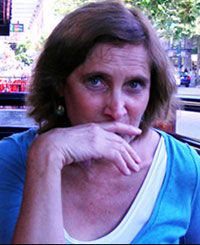Sowing Seeds Indoors
Sowing Seeds Indoors
By Deborah Clark
NABBW’s Gardening Expert

Once upon a time, I lived in a very cold place where the winters (measured by the first and last frost dates) lasted from Aug. 15 to June 15. This was back in the old days.
This was back in the old days. I understand that Burlington winters haven\’t been so bad in the last few decades. As a budding (no pun intended, of course) vegetable gardener, I did what I had to do: started seeds indoors.
Back then, I rented a community plot and also plowed up the back yard and grew vegetables galore – enough to can tomatoes and cucumber pickles that lasted the entire winter.
Another reason I had to start vegetables from seed is that I was very poor and couldn\’t afford to pay for fully grown plants in the spring.
Every sunny surface indoors became part of my garden – the back of the toilet tank, window sills, tables, and shelves all supported the sawed-off bottoms of milk and juice cartons containing potting soil and vegetable seeds. I grew tomatoes, zucchini, basil, cucumbers, Bibb lettuce, eggplant, banana peppers, broccoli, Brussels sprouts and more.
Fast forward several decades to see me, now, for the first time in more than 30 years starting seeds indoors. Yes, I\’ve had vegetable gardens in the meantime but I\’ve been able to afford to buy starter plants: My reason now for starting plants from seed is different than before.
Who knew back then that some day in the future a company would try to buy up all the seeds in the world, patent them, and modify their genes?! Like many others, I\’m alarmed by the assault Monsanto has been making on seeds, creating suffering among farmers around the world. And so I\’m inspired to purchase heirloom seeds and maybe even save some myself.
My vegetable garden does not have the advantage of being in full sun for very many hours – too few hours, in fact, for many vegetables. But I\’ve discovered precious heirloom varieties that thrive in shade and part shade: Black-seeded blue lake snap pole beans, Beam\’s yellow pear tomatoes, Costaluto Genovese tomatoes, Joe\’s cayenne pepper, cocozelle squash and crookneck squash all produce prolifically in just a few hours of direct sun.
My vegetable garden does not have the advantage of being in full sun for very many hours – too few hours, in fact, for many vegetables. But I\’ve discovered precious heirloom varieties that thrive in shade and part shade: Black-seeded blue lake snap pole beans, Beam\’s yellow pear tomatoes, Costaluto Genovese tomatoes, Joe\’s cayenne pepper, cocozelle squash and crookneck squash all produce prolifically in just a few hours of direct sun.
Both these companies make me feel like I belong to a community. Seed Savers seeds especially, come with the names of those who have provided seed to the Heritage Farm in Decorah, Iowa.
Now that my new patio is finished (I decided to go with the saw-cut blue stone and am glad I did!) I\’m also going to get some 5 and 10 gallon pots from Smart Pots for growing veggies in containers. I\’ll be reporting on that sometime soon.
Deborah Clark says she might never have taken up gardening if she hadn’t had neighbors who shared their love of gardening with her – but moved away. It all started in 1973, she says, when a departing neighbor invited her to take care of an already-planted community vegetable garden plot: all she had to do was weed and harvest. She was hooked.




